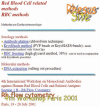The Rhesus Site
- PMID: 25538538
- PMCID: PMC4264492
- DOI: 10.1159/000366176
The Rhesus Site
Abstract
The Rhesus Site is a resource for information of the 'Rhesus' blood group. It is intended for specialists and non-specialists. The website details research in the field relevant for transfusion medicine, immunohematology, and molecular research. Link areas guide to important publications and to methodological resources for Rhesus. Many data originally presented at The Rhesus Site have been formally published later. The 'RhesusBase' section represents the largest database for RHD alleles; the 'RhesusSurveillance' section details the results of the largest prospective observational study on anti-D immunization events in D-positive patients. Visitors to the website are encouraged to explore the intricacies of the most complex blood group gene locus.
Keywords: Antigen D; Databases as topic; Immunization; Rh blood group; Rh-Hr blood group system.
Figures




References
-
- Lomas C, Tippett P, Thompson KM, Melamed MD, Hughes-Jones NC. Demonstration of seven epitopes on the Rh antigen D using human monoclonal anti-D antibodies and red cells from D categories. Vox Sang. 1989;57:261–264. - PubMed
-
- Jones J, Filbey D. Selection of monoclonal antibodies for the identification of D variants: ability to detect weak D and to split epD2, epD5 and epD6/7. Vox Sang. 1996;70:173–179. - PubMed
-
- First International Workshop on Monoclonal Antibodies Against Red Blood Cell and Related Antigens. Paris, September 21–24, 1987. Vol. II: Other blood group systems. Rev Fr Transfus Immunohematol. 1988;31:115–486. - PubMed
-
- Proceedings of the Second International Workshop and Symposium on Monoclonal Antibodies Against Human Red Blood Cells and Related Antigens. J Immunogenet. 1990;17:213–357. 1–4 April, 1990, Lund, Sweden. - PubMed
-
- Proceedings of the 3rd International Workshop and Symposium on Monoclonal Antibodies against Red Blood Cells and Related Antigens. Transfus Clin Biol. 1996;3:329–541. Nantes, 25–27 September 1996. - PubMed
Publication types
LinkOut - more resources
Full Text Sources
Other Literature Sources

